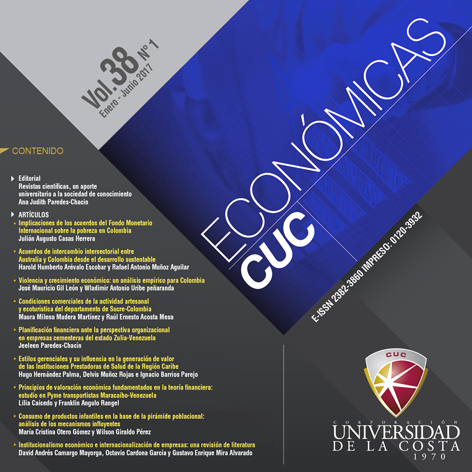Acuerdos de intercambio intersectorial entre Australia y Colombia desde el desarrollo sustentable
DOI:
https://doi.org/10.17981/econcuc.38.1.02Palabras clave:
acuerdos de intercambio, desarrollo sostenible, crecimiento económico, estructura política, sectores productivosResumen
El presente artículo permite evaluar la viabilidad de un acuerdo de intercambio intersectorial entre Australia y Colombia desde el marco del desarrollo sustentable, comparando los indicadores económicos suministrados por el Banco Mundial desde los años noventa hasta el año 2015, con el fin de determinar la viabilidad de un intercambio intersectorial. La metodología utilizada, responde a una investigación de tipo descriptiva documental, diseño no experimental. Para la técnica se estableció la revisión documental del Atlas de la Complejidad Económica. Se determinó, la importancia de que prevalezca sinergia entre los factores económicos y el desarrollo sustentable para los acuerdos de intercambio intersectorial. En consecuencia, se requiere alcanzar una estructura de sostenibilidad por lo que se definen indicadores económicos sustentables de alcance entre los dos países.
Descargas
Citas
Clavijo, S. (2012). La desindustrialización en Colombia, análisis cuantitativo de sus determinantes. Bogotá: Colombia: Anif.
Echeverri, J.C. (2014). La Visión de la prosperidad del Gobierno Santos. Bogotá: Dotec
González, M. (2014) Análisis crítico sobre la conceptualización y medición de la ecoeficiencia empresarial. Ciencia en su PC. Centro de información y gestión tecnológica de Santiago de Cuba. (2). 93-107
González, M. (2014, abril-junio). Análisis crítico sobre la conceptualización y medición de la ecoeficiencia empresarial. Ciencia en su PC. Centro de información y gestión tecnológica de Santiago de Cuba. (2). 93-107.
Haussmann, R., Hidalgo, C. A., Bustos, S., et.al. (2011). Atlas de la Complejidad Económica. Cambridge. Estados Unidos: Draft.
Haussmann, R; e Hidalgo, C. A. (2014). The atlas of economic complexity: Mapping paths to prosperity, Cambridge. Estados Unidos: MIT Press
Inda, C.M. y Vargas, J.G. (2012). Ecoeficiencia y competitividad: tendencias y estrategias con metas comunes. EIDENAR, (11). 33-40.
López & Gentile (S/F), Sistema de indicadores económicos y sociales: la importancia del análisis integrado. Argentina: Fac. de Ciencias Económicas y Sociales; Universidad Nacional de Mar del Plata. Recuperado de: https://eco.mdp.edu.ar/cendocu/repositorio/00408.pdf
Marchini, G. (2012). Las economías primario exportadoras de Oceanía y América Latina: Australia, Nueva Zelanda, Chile y Perú. Revista Crecimiento económico y desarrollo financiero Asia-Pacífico. (11). 4-20
Massachusetts Institute of Technology. (2015). The Observatory of Economic Complexity. Usa: Recuperado de: http://atlas.media.mit.edu/en/
Ocampo, J.A.; Lasso F.J.; Tovar, C.E. et.al (1997). Macroeconomía, ajuste estructural y equidad en Colombia 1978-1996. Bogotá, Colombia: Departamento Nacional de Planeación.
Organización de las Naciones Unidas (2015). Informe General 2015 sobre Desarrollo Humano. Recuperado de: http://www.undp.org/content/undp/es/home/search.html?q=Indice+de+desarrollo+humano
Stuart, A. (junio de 2014). De cara a Asia. Revista Finanzas y Desarrollo. 51(2).1-4
Villanueva, J. (2012). Actualidad de la teoría de la complejidad en economía. Informes de Economía e Instituciones. Recuperado de: http://www.uca.edu.ar/uca/common/grupo83/files/2012-03_Villanueva.pdf
Descargas
Publicado
Cómo citar
Número
Sección
Licencia
Usted es libre de:
- Compartir — copiar y redistribuir el material en cualquier medio o formato
- La licenciante no puede revocar estas libertades en tanto usted siga los términos de la licencia
Bajo los siguientes términos:
- Atribución — Usted debe dar crédito de manera adecuada , brindar un enlace a la licencia, e indicar si se han realizado cambios . Puede hacerlo en cualquier forma razonable, pero no de forma tal que sugiera que usted o su uso tienen el apoyo de la licenciante.
- NoComercial — Usted no puede hacer uso del material con propósitos comerciales .
- SinDerivadas — Si remezcla, transforma o crea a partir del material, no podrá distribuir el material modificado.
- No hay restricciones adicionales — No puede aplicar términos legales ni medidas tecnológicas que restrinjan legalmente a otras a hacer cualquier uso permitido por la licencia.


 English
English
 Español (España)
Español (España)














